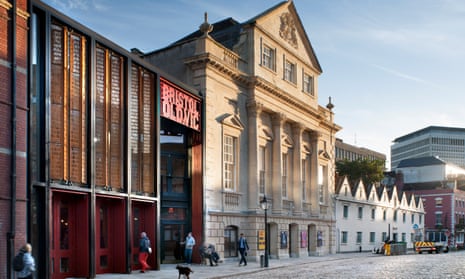One of the world’s most historic theatres – Bristol Old Vic – has launched an ambitious new heritage project intended to both explain its astonishing 252-year history and entice in people who may not think theatre is relevant for them.
The “heritage experience” ranges from corridors crammed with images of old theatre playbills and posters to a vibrant, typically quirky animation from local studio Aardman that tells the story of the theatre. The film will be projected on to a newly exposed higgledy-piggledy stone facade as a sort of cartoon prelude to each evening performance.
In addition, visitors will be able to get an idea of what the theatre was like throughout the ages via an “augmented reality app” available via iPads and smartphones while those who prefer their history to involve cramped, dusty spaces will be delighted at the prospect of a tour of the attic, which features the original 18th-century “thunder run” – a contraption involving wooden chutes and balls that mimics the sound of a storm.
At the heart of the redevelopment is a desire to make what is claimed to be the oldest continuously working theatre in the English-speaking world more accessible and tempt people in at all times of the day, not just for performances.
Tom Morris, the theatre’s artistic director, said: “We have an extraordinary piece of history that is still in working order. It is as if Stephenson’s Rocket was operating a passenger service into Manchester. The challenge was how to share it.
“However radical, forward-looking and accessible our programme is, there is still in some places a preconception that theatre is a backwards-looking art form and nobody in their right mind would go there to have fun. We’re working to confront that.”
The heritage project is the final stage of a multimillion-pound reinvention and redevelopment. A rebuild of the auditorium that was completed in 2012 included moving the stage so far forward actors feel as if they are within touching distance of almost the whole audience.
Since then the theatre has unveiled a sparkling glass foyer that finally makes the building feel part of King Street (in its early days it was hidden behind two houses and may have been accessible only through a hidden passage because theatre was considered dangerous and seditious). It has also tried to insure itself against cuts by launching a new conference and banqueting business.
Morris said he hoped the heritage offer would show people that theatre could and should still be relevant to all, as well as getting in more people through the front doors. “It’s important that we use our subsidy to make sure there is a genuine welcome for everyone in the city and region whatever their background,” he said.
There are certainly delights. A mural tells the stories of some of those who have been associated with the theatre and its environs, from bear-baiters to the Romantic poets and even Paul McCartney, who may have got the name Rigby for the Beatles song Eleanor Rigby from a nearby shop as he waited for Jane Asher to come out of the theatre.
Another work of art celebrates actors with close links to Bristol Old Vic such as Peter O’Toole, while a grim element of the theatre’s past – merchants who bankrolled the theatre in 1766 to some extent built their wealth on the slave trade – is also addressed.
Perusal of the posters and bills provides hours of fun. One from 1827 reveals delights including a “Canary Concert” and an act by Mr Usher the clown that involves the “astonishing deception of swallowing his own head”.
But some things do not change. A poster from 1844 advertises a performance of A Christmas Carol “sanctioned by Charles Dickens esq”. This Christmas’s show at the theatre? A new version of Dickens’ festive classic.
Bristol Old Vic’s heritage experience is open to the public from 10 November
